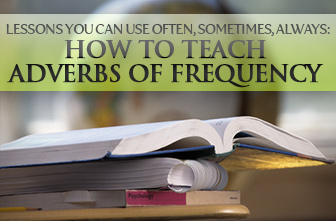Lessons You Can Use Often, Sometimes, Always: Teaching Adverbs of Frequency


There are many ways in which you can approach bringing the topic to light. Through a lot of trial and error, I have devised these five advantageous tips to introducing Adverbs of Frequency.

It can be somewhat challenging to define all the adverbs of frequency at one time with limited language. One skillful way to introduce all the new vocabulary and provide an interactive feel to the grammar point is to make a list of all the adverbs the class knows and then add in the ones they don’t. As you create the list with student input, write it out on the board in descending order from frequent to infrequent. Once you have a substantial list, you can talk about degrees of frequency and add other interchangeable phrases. In discussing the degrees, you can assign the adverbs a percentage of frequency to give more concrete definition to the words. Here is an example:
| Always, regularly | 90 to 100% of the time (every day or several days a week) |
| Usually | |
| Often | 70 to 80 % of the time (one or two days a week) |
| Frequently | |
| Sometimes | 50% of the time (twice a month) |
| Occasionally | |
| Rarely | 20-40% of the time (three times a year) |
| Hardly ever | |
| Never | 0 to 10% of the time (once a year, if at all) |
With this introduction, you can then determine the difference between words like often and frequently, or sometimes and occasionally. It is pretty subjective. You can also add in other adverbs that may have been overlooked like: seldom, normally, generally, etc. This is also a good time to introduce how many times per day/week/month/year you do something.
In presenting the placement of adverbs, you’ll want to show the students and then have them deduct from your examples, where the adverbs go. There are three options, but the first two are the main ways to express frequency. You can also point out that it is acceptable to give short answers or answers that contain x times per week/month/year.
| Q: | How often do you go to the movies? | |
| A: | I occasionally go to the movies. | In between the subject and the verb |
| Sometimes I go to the movies. | At the very beginning | |
| I go to the movies rarely. | At the very end (never doesn’t fit here) |
A reliable way to practice both the vocabulary and the placement of adverbs is to come up with a list of activities and have the students ask and answer question with How often do you… workout/eat sushi/drive a car…
If you provide the students with only the prompts, they will practice formulating the questions, as well as answering them. A valuable follow-up activity to the how often question is, do you always/sometimes/ do something. Point out that we sometimes ask questions like, do you always go skiing on the weekends? This type of question is usually asked when we notice that someone has a particular habit and we can then ask the person questions about that habit. You can also do a find someone who activity and provide prompts with adverbs of frequency. For example:
Find someone who….
They can then make sentences about the information like, John eats pizza rarely or Mario watches TV occasionally. This activity helps students to practice the correct forms of present tense, placement of the adverbs, and question formation.
The truth and lie game is a fun and fairly simple way to practice adverbs of frequency. Tell students to think of three facts about their habits, with one fact being untrue. You can also inform students that the point of the game is to be a good liar. They want to fool the rest of the group. Once they have devised their 3 facts, they can be written on the board or stated aloud. The class then votes on which one is the lie.
An example could be:
You could also have the class ask yes or no questions to try to determine which fact is untrue.
Surveys are very useful for this grammar point because it enables students to deduce information from the answers. Create a basic survey about habits and have students talk to one another to get the answers. If you include things such as likes, dislikes, frequencies, and habits, the students will have to ask different types of questions.
You could do this as one big group or in pairs. Then you spend time tallying the results of the survey together as a group. At this point, the students can then make sentences from the information extracted from the survey. Results could be something like: Everyone in the class always does their homework. Several students go to the movies frequently.
Bring these five advantageous tips into the classroom, and your students will obtain a solid foundation and understanding of adverbs of frequency.